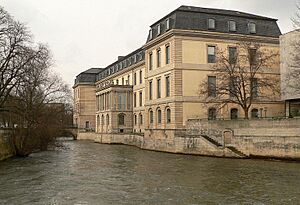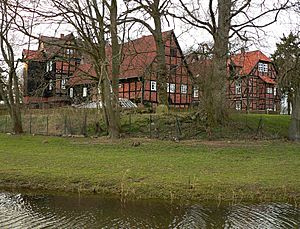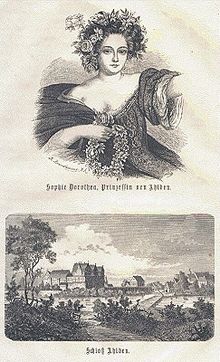Sophia Dorothea of Celle facts for kids
Quick facts for kids Sophia Dorothea of Celle |
|
|---|---|
| Electoral Princess of Hanover Duchess of Ahlden |
|

Portrait from the 1690s. Currently displayed at the Residence Museum (Residenzmuseum) in Celle Castle.
|
|
| Born | 15 September 1666 Celle Castle, Celle, Principality of Lüneburg |
| Died | 13 November 1726 (aged 60) Ahlden, Germany |
| Burial | May 1727 Stadtkirche, Celle |
| Spouse | |
| Issue | |
| House | Hanover |
| Father | George William, Duke of Brunswick-Lüneburg |
| Mother | Éléonore Desmier d'Olbreuse |
Sophia Dorothea of Brunswick-Lüneburg-Celle (born September 15, 1666 – died November 13, 1726) was a princess who later became the wife of George Louis. He would become the future King George I of Great Britain. Their marriage was arranged by their families for political reasons. Sophia Dorothea is mostly remembered because she was imprisoned for the last thirty years of her life. This happened after rumors spread about her friendship with Count Philip Christoph von Königsmarck.
Contents
Sophia Dorothea's Life Story
Early Years and Family
Sophia Dorothea was born in Celle on September 15, 1666. She was the only child of George William, Duke of Brunswick-Lüneburg. Her mother was Éléonore Desmier d'Olbreuse, a French noblewoman. Sophia Dorothea grew up in a happy and caring home.
Her father gave her a lot of money and property over time. This was to make her a better candidate for marriage. Her family's standing improved even more in 1674. This happened when she and her mother received the title of Countess of Harburg and Wilhelmsburg. This was a reward for her father's help to Emperor Leopold I.
Many important people wanted to marry Sophia Dorothea. These included princes and even the King of Sweden. Her parents first agreed for her to marry a prince from Brunswick-Wolfenbüttel. But he was badly hurt in a battle and died in 1676.
Marriage and Royal Status
After her first fiancé died, Sophia Dorothea's father wanted to arrange another important marriage. He talked to his younger brother, Ernest Augustus, Elector of Brunswick-Lüneburg. He hoped to arrange a marriage between Sophia Dorothea and Ernest Augustus's oldest son, George Louis. George Louis would later become King George I of Great Britain.
At first, George Louis's parents were not sure about the marriage. This was because Sophia Dorothea's parents had not been officially married when she was born. To fix this, Sophia Dorothea's father officially married her mother in 1676. This made Sophia Dorothea a legitimate princess.
This change worried George William's relatives. They were concerned about who would inherit the family lands. But in 1680, the family agreed to recognize Sophia Dorothea as a princess. They also agreed to the marriage between her and George Louis. Even though Sophia Dorothea and her mother were against it, the wedding went ahead.
The wedding took place on November 21, 1682. The marriage was not happy. George Louis and his mother, Sophia of the Palatinate, did not think highly of Sophia Dorothea. They felt she was not as refined as they were. George Louis was often cold to his new wife. They had many loud arguments.
Despite their problems, they had two children. Their son, George Augustus, was born in 1683. He later became King George II of Great Britain. Their daughter, Sophia Dorothea, was born in 1687. She later became Queen of Prussia. After having children, George Louis spent more time with another woman. His parents worried this would affect the money he was supposed to get from Sophia Dorothea's family.
Friendship with Count Königsmarck
Around 1690, Sophia Dorothea met Philip Christoph von Königsmarck again. She had known him when they were children. At first, they met only sometimes. But by 1691, they became very close. People at the Hanoverian court started to notice their friendship. By 1694, rumors were spreading that they were having a secret relationship.
After a big argument with her husband, Sophia Dorothea visited her parents in Celle. She hoped they would support her in separating from her husband. But her parents did not agree. Her father needed his brother's help in a war. So, he sent Sophia Dorothea back to Hanover.
In the summer of 1694, Sophia Dorothea, Königsmarck, and her lady-in-waiting planned to escape. They hoped to find safety with another duke or in Saxony.
Königsmarck's Disappearance
Countess Clara Elisabeth von Platen was a former friend of George Louis's father. She found out about Sophia Dorothea and Königsmarck's escape plan. She told George Louis about it.
On the night of July 11, 1694, Königsmarck met Sophia Dorothea at the Leineschloss. After this meeting, he disappeared. It is believed he was killed on orders from George Louis or his father. His body was likely thrown into the Leine river. Four of the Elector's guards were said to have done it. One of them received a very large sum of money. Königsmarck's body was never found.
Even the King of France and the King of Poland tried to find out what happened. But they could not solve the mystery. In 2016, some bones were found at the Leineschloss. People thought they might be Königsmarck's, but tests showed it was unlikely.
Letters Between Sophia Dorothea and Königsmarck
Before his disappearance, Königsmarck gave his letters with Sophia Dorothea to his brother-in-law. Later, this family tried to sell the letters to the Hanoverian royal family. But the price was too high, and the court questioned if the letters were real.
The letters were published in the mid-1800s. Most of them are now at Lund University in Sweden. A few ended up with Sophia Dorothea's grandson, King Frederick the Great of Prussia. Today, we know for sure that these letters are real.
The letters were rarely dated, but most were numbered. Historians believe there were originally hundreds of letters exchanged. Many seem to have been taken and destroyed by the Hanoverian authorities. Even other family letters from that time were changed to hide details.
Divorce and Imprisonment
George Louis wanted to divorce his wife. He said she was at fault for leaving him. During the divorce process, Sophia Dorothea was arrested and held in Lauenau Castle. On December 28, 1694, their marriage was officially ended. Sophia Dorothea was blamed for "maliciously leaving her husband."
She was not allowed to marry again or see her children. Her name was removed from official papers. She lost her title of Electoral Princess. Churches in Hanover were told not to mention her name in prayers. After the divorce, George Louis sent her to Ahlden House. This was a large house in the countryside that became her prison.
Sophia Dorothea was imprisoned for life. This was ordered by her former husband and agreed to by her father. George Louis took her money and property. He gave her a yearly allowance for herself and her staff. She was kept in one part of the castle. She was guarded 24 hours a day by many men. Her mail and visitors were carefully checked. However, her mother could visit her whenever she wanted. Sophia Dorothea never tried to escape.
At first, she could only walk in the castle courtyard. Later, she was allowed to go into the gardens with guards. After two years, she could take supervised trips outside the walls. Her stay at Ahlden was sometimes interrupted. This happened during wars or when the house was being fixed. During these times, she was moved to Celle Castle or Essel. Her staff were chosen because they were loyal to Hanover.
After her imprisonment, Sophia Dorothea was known as the Duchess of Ahlden. At first, she seemed sad and accepting of her fate. But in later years, she tried to get released. When her former father-in-law died in 1698, she wrote to her former husband. She told him she prayed for him daily and begged him to forgive her. She hoped he would let her see her children. She also wrote to her former mother-in-law. Neither George Louis nor his mother replied.
In 1705, Sophia Dorothea's father was dying. He wanted to see her one last time. But his chief advisor said it could cause problems with Hanover. So, George William died without seeing his daughter.
Sophia Dorothea is remembered for her kindness during her imprisonment. In 1715, a big fire destroyed much of Ahlden. She gave a lot of money to help rebuild the town.
Death and Burial
Sophia Dorothea's mother died in 1722, leaving her alone. In 1725, Sophia Dorothea's daughter, the Queen in Prussia, visited her father. He was now King George I of Great Britain. Sophia Dorothea waited at her window every day. She hoped to see her daughter, but it never happened.
Sophia Dorothea gained weight and often had colds and stomach problems. In early 1726, she had a stroke. In August, she became very ill with stomach pain. She refused to eat or get treatment. She died on November 13, 1726, at age 60. Doctors found problems with her liver and gallbladder.
Her former husband, King George I, announced her death. But he forbade anyone in London or Hanover from mourning her. He was very angry when his daughter's court in Berlin wore black.
Sophia Dorothea's body was placed in a lead coffin. It was kept in a cellar. In January 1727, an order came to bury her without a ceremony. But heavy rain made it impossible. The coffin was put back in the cellar and covered with sand. Finally, in May 1727, Sophia Dorothea was secretly buried at night. She was laid to rest next to her parents in the Stadtkirche in Celle. King George I died four weeks later while visiting Hanover.
Inheritance
Sophia Dorothea's parents seemed to believe she would be released one day. In January 1705, her father and mother made a will. It said Sophia Dorothea would inherit several estates and her parents' wealth. Her father named someone to manage her money. But this person died six years before Sophia Dorothea did.
Other Interesting Facts
- Eleonore von dem Knesebeck was Sophia Dorothea's lady-in-waiting. She was imprisoned in 1695. After two years, she escaped. She wrote messages on the walls of her prison room. These messages were poems and stories about her enemies.
- A French adventurer claimed he received many love letters from Sophia Dorothea. But he never showed them to anyone.
- Sophia Dorothea's great-granddaughter, Caroline Matilda of Great Britain, also became a queen. She was divorced from her husband and separated from her children. She was sent to Celle Castle, where she died. Both women are buried in the same church crypt.
- In 1804, the famous writer Friedrich von Schiller planned a play about Sophia Dorothea. It was to be called The Princess of Celle, but he never finished it.
Film About Sophia Dorothea
Sophia Dorothea's story was made into a British film. It was called Saraband for Dead Lovers (1948). Joan Greenwood played Sophia Dorothea, and Stewart Granger played Königsmarck.
Images for kids
-
Sophia Dorothea, by Henri Gascar, 1686. This painting is at the Celle Castle museum.
-
Philip Christoph von Königsmarck, anonymous portrait, around 1690s. This painting is at the Celle Castle museum.







